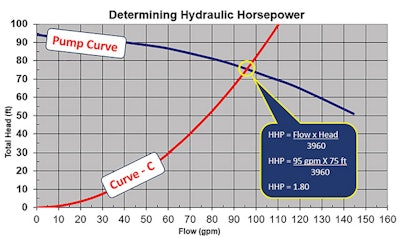
Hydraulic horsepower is the new standard by which we determine the size and performance of pool pumps. Our industry's traditional method of identifying a pump's size was Rated Horsepower, but when the new DOE regulations go into effect next year, Rated HP will no longer be important. Pump labels won't be allowed to show Rated HP. Instead, there will be new ways to compare pumps. So we say to Rated HP…adios!
A PAINFUL BUT NEEDED CHANGE
As painful as this transition may be, there's actually a good reason for it. Truth is, our traditional Rated HP was not a standardized value. At best, it was only a relative performance indicator within a single manufacturer's product family. Other than it having to fall into a select group of "buckets" (i.e., ½, ¾, 1, 1½, 2, 2½, 3 HP buckets), there were minimal similarities amongst a specifi c HP rating. For example, a 1½-HP pump from one manufacturer would likely perform quite differently from a competing manufacturer's 1½-HP pump. Even within a single manufacturer the 1½ HP pumps were not consistent, e.g., 1½-HP SuperFlo pump was different than a 1½-HP WhisperFlo pump. Some of this variance was intentional to account for higher head versus medium head designs, but the point here is that there were no standardized parameters around what a 1½-HP pump should do. Adding to the confusion, the exact same pump design could have two different rated HPs — an up-rate or full-rate — as our industry has historically done for decades. For example, a single pump design could carry two different model numbers with two different ratings — one pump is labeled 1 HP with a 1.65 service factor while the other pump is labeled at 1½ HP with a 1.10 service factor…the exact same pump with two different horsepower ratings. This needed to change!
RELATED: New DOE Rules Set to Eliminate Many Single-Speed Pumps
To be fair, a savvy pool professional has always had the ability to accurately determine a pump's true performance in each specific application by using a pump curve and pressure gauge. But let's be real, how many of us industry professionals regularly refer to a pump curve and pressure gauge to properly select and apply the appropriate pump, regardless of its nameplate Rated HP? If you're one of the few using this technique, then I salute you and applaud your professionalism.
VOILA HYDRAULIC HORSEPOWER
With Hydraulic horsepower, we now have a system that more accurately determines a pump's performance. While I still recommend the use of pump curves and pressure gauges for determining optimum performance, this new method is much more forgiving when comparing the performance of various pumps.

Hydraulic HP is assigned by the manufacturer and is determined by testing the pump design with a level of laboratory precision. It is very specific to that pump design. It's typically displayed to 2 or 3 decimal places, e.g., 0.573 HHP, or maybe 2.43 HHP. It is not required (actually not allowed) to fit into one of the traditional buckets. As evident in the following equation, there is both a fl ow and pressure component that determines the HHP value. Here is a simplified equation for determining HHP:
HHP = (Flow [gpm] x Head [ft]) / 3960
HHP IS A CONSISTENT VALUE SUITABLE TO MAKE COMPARISONS
To keep HHP consistent and usable across all pumps and all manufacturers, standardized hydraulic conditions were established. This standardized condition is known as a Curve-C hydraulic system. Curve-C was established to roughly represent the hydraulic conditions of a typical 20,000 gallon pool with 2-inch plumbing and a cartridge filter. This is a standardized rating method which is prevalent across many consumer products. For example, the automotive industry has standardized conditions for determining a vehicle's max towing capacity. When Ford claims a 7000-lb. tow capacity, and Chevy claims a 9000- lb. tow capacity, these standardized test methods allow the consumer to make head-to-head comparisons between these vehicles.
RELATED: New Age of Pumps: Selling the Homeowners
For the purpose of product labeling, HHP is determined at the pump's maximum RPM, which means it's the maximum HPP available under the standardized conditions. HHP is not intended to provide an exact performance on your particular pool; it is intended to give a standardized way to compare pumps. For example, a 1.324 HHP pump will have higher performance than a 0.982 HHP pump, which is an important distinction that the Rated HP method could not adequately provide.
WHAT ABOUT TOTAL HP?
HHP should not be confused with Total HP (THP), which is also known as Service Factor HP (SFHP). Total HP is a measure of the motor's capability (how much power is available from the motor shaft), while HHP is a measure of the pump's wet-end performance (how much flow can be delivered from the impeller and diffuser). Let's compare two different pumps with the same HHP. One pump has a 1.0 THP motor while the other has a 2.0 THP motor. The result is the bigger motor doesn't offer more flow since it is the hydraulic HP that determines the wetend's performance. However, the DOE regulation requires the less useful THP to appear on every pump's nameplate label, while HHP, the more useful measure, is voluntary. Buyer beware of selecting a pump based solely on its THP.
RELATED: Selling Variable Speed
 Curve-C represents the hydraulic conditions of a typical 20,000 gallon pool with 2-inch plumbing and a cartridge filter. A pump's HHP rating is the point of intersection between the pump's performance curve (blue line, at left) and Curve-C.
Curve-C represents the hydraulic conditions of a typical 20,000 gallon pool with 2-inch plumbing and a cartridge filter. A pump's HHP rating is the point of intersection between the pump's performance curve (blue line, at left) and Curve-C.
VARIABLE SPEED PUMPS MAKE IT EASY
So how does this information help you select the best pump for a particular pool? In cases where you're replacing a pump that has already failed, there's no opportunity to measure the hydraulic condition of the plumbing system, or dial in the existing pump's performance and compare it to a possible replacement. And you can't rely on Rated HP to select a replacement pump, either. Under the new DOE regulations, a like-for-like replacement may no longer be available. Each manufacturer will be providing a replacement guide to aid in the transition period. Herein lies the beauty of a variable speed pump. A variable speed pump can replace almost any existing pump because it can be set up for optimum performance by simply adjusting the speed or the flow. Remember, there is nothing that a single speed pump can do that a variable speed pump can't do at least as well, if not better. And while a variable speed pump can't necessarily overcome a poor hydraulic system, it can give you the best-case optimum pump performance for the given conditions.
IN CONCLUSION
While HHP doesn't provide all the answers, it is a much improved way to determine the relative performance of various pump models and greatly helps avoid choosing a pump that results in inadequate flow capabilities.
Jeff Farlow is program manager of energy initiatives for Pentair, and an expert on pool pumps. More information on DOE regulations can be found at www.pentair.com/pumpregulations.











































